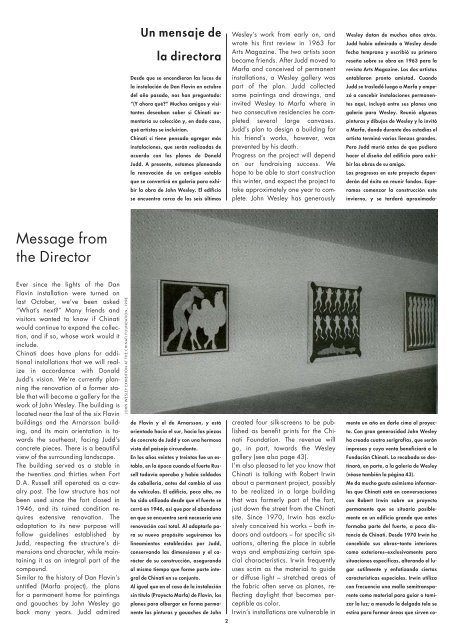Robert Irwin con Marianne Stockebrand - The Chinati Foundation
Robert Irwin con Marianne Stockebrand - The Chinati Foundation
Robert Irwin con Marianne Stockebrand - The Chinati Foundation
You also want an ePaper? Increase the reach of your titles
YUMPU automatically turns print PDFs into web optimized ePapers that Google loves.
Message from<br />
the Director<br />
Ever since the lights of the Dan<br />
Flavin installation were turned on<br />
last October, we’ve been asked<br />
“What’s next?” Many friends and<br />
visitors wanted to know if <strong>Chinati</strong><br />
would <strong>con</strong>tinue to expand the collection,<br />
and if so, whose work would it<br />
include.<br />
<strong>Chinati</strong> does have plans for additional<br />
installations that we will realize<br />
in accordance with Donald<br />
Judd’s vision. We’re currently planning<br />
the renovation of a former stable<br />
that will become a gallery for the<br />
work of John Wesley. <strong>The</strong> building is<br />
located near the last of the six Flavin<br />
buildings and the Arnarsson building,<br />
and its main orientation is towards<br />
the southeast, facing Judd’s<br />
<strong>con</strong>crete pieces. <strong>The</strong>re is a beautiful<br />
view of the surrounding landscape.<br />
<strong>The</strong> building served as a stable in<br />
the twenties and thirties when Fort<br />
D.A. Russell still operated as a cavalry<br />
post. <strong>The</strong> low structure has not<br />
been used since the fort closed in<br />
1946, and its ruined <strong>con</strong>dition requires<br />
extensive renovation. <strong>The</strong><br />
adaptation to its new purpose will<br />
follow guidelines established by<br />
Judd, respecting the structure’s dimensions<br />
and character, while maintaining<br />
it as an integral part of the<br />
compound.<br />
Similar to the history of Dan Flavin’s<br />
untitled (Marfa project), the plans<br />
for a permanent home for paintings<br />
and gouaches by John Wesley go<br />
back many years. Judd admired<br />
JOHN WESLEY EXHIBITION AT THE CHINATI FOUNDATION, 1998<br />
Un mensaje de<br />
la directora<br />
Desde que se encendieron las luces de<br />
la instalación de Dan Flavin en octubre<br />
del año pasado, nos han preguntado:<br />
“(Y ahora qué?” Muchos amigos y visi-<br />
tantes deseaban saber si <strong>Chinati</strong> au-<br />
mentaría su colección y, en dado caso,<br />
qué artistas se incluirían.<br />
<strong>Chinati</strong> sí tiene pensado agregar más<br />
instalaciones, que serán realizadas de<br />
acuerdo <strong>con</strong> los planes de Donald<br />
Judd. A presente, estamos planeando<br />
la renovación de un antiguo establo<br />
que se <strong>con</strong>vertirá en galería para exhi-<br />
bir la obra de John Wesley. El edificio<br />
se encuentra cerca de los seis últimos<br />
de Flavin y el de Arnarsson, y está<br />
orientado hacia el sur, hacia las piezas<br />
de <strong>con</strong>creto de Judd y <strong>con</strong> una hermosa<br />
vista del paisaje circundante.<br />
En los años veintes y treintas fue un es-<br />
tablo, en la época cuando el fuerte Rus-<br />
sell todavía operaba y había soldados<br />
de caballería, antes del cambio al uso<br />
de vehículos. El edificio, poco alto, no<br />
ha sido utilizado desde que el fuerte se<br />
cerró en 1946, así que por el abandono<br />
en que se encuentra será necesaria una<br />
renovación casi total. Al adaptarlo pa-<br />
ra su nuevo propósito seguiremos los<br />
lineamientos establecidos por Judd,<br />
<strong>con</strong>servando las dimensiones y el ca-<br />
rácter de su <strong>con</strong>strucción, asegurando<br />
al mismo tiempo que forme parte inte-<br />
gral de <strong>Chinati</strong> en su <strong>con</strong>junto.<br />
Al igual que en el caso de la instalación<br />
sin título (Proyecto Marfa) de Flavin, los<br />
planes para albergar en forma perma-<br />
nente las pinturas y gouaches de John<br />
2<br />
Wesley’s work from early on, and<br />
wrote his first review in 1963 for<br />
Arts Magazine. <strong>The</strong> two artists soon<br />
became friends. After Judd moved to<br />
Marfa and <strong>con</strong>ceived of permanent<br />
installations, a Wesley gallery was<br />
part of the plan. Judd collected<br />
some paintings and drawings, and<br />
invited Wesley to Marfa where in<br />
two <strong>con</strong>secutive residencies he completed<br />
several large canvases.<br />
Judd’s plan to design a building for<br />
his friend’s works, however, was<br />
prevented by his death.<br />
Progress on the project will depend<br />
on our fundraising success. We<br />
hope to be able to start <strong>con</strong>struction<br />
this winter, and expect the project to<br />
take approximately one year to complete.<br />
John Wesley has generously<br />
created four silk-screens to be published<br />
as benefit prints for the <strong>Chinati</strong><br />
<strong>Foundation</strong>. <strong>The</strong> revenue will<br />
go, in part, towards the Wesley<br />
gallery (see also page 43).<br />
I’m also pleased to let you know that<br />
<strong>Chinati</strong> is talking with <strong>Robert</strong> <strong>Irwin</strong><br />
about a permanent project, possibly<br />
to be realized in a large building<br />
that was formerly part of the fort,<br />
just down the street from the <strong>Chinati</strong><br />
site. Since 1970, <strong>Irwin</strong> has exclusively<br />
<strong>con</strong>ceived his works – both indoors<br />
and outdoors – for specific situations,<br />
altering the place in subtle<br />
ways and emphasizing certain special<br />
characteristics. <strong>Irwin</strong> frequently<br />
uses scrim as the material to guide<br />
or diffuse light – stretched areas of<br />
the fabric often serve as planes, reflecting<br />
daylight that becomes perceptible<br />
as color.<br />
<strong>Irwin</strong>’s installations are vulnerable in<br />
Wesley datan de muchos años atrás.<br />
Judd había admirado a Wesley desde<br />
fecha temprana y escribió su primera<br />
reseña sobre su obra en 1963 para la<br />
revista Arts Magazine. Los dos artistas<br />
entablaron pronto amistad. Cuando<br />
Judd se trasladó luego a Marfa y empe-<br />
zó a <strong>con</strong>cebir instalaciones permanen-<br />
tes aquí, incluyó entre sus planes una<br />
galería para Wesley. Reunió algunas<br />
pinturas y dibujos de Wesley y lo invitó<br />
a Marfa, donde durante dos estadías el<br />
artista terminó varios lienzos grandes.<br />
Pero Judd murió antes de que pudiera<br />
hacer el diseño del edificio para exhi-<br />
bir las obras de su amigo.<br />
Los progresos en este proyecto depen-<br />
derán del éxito en reunir fondos. Espe-<br />
ramos comenzar la <strong>con</strong>strucción este<br />
invierno, y se tardará aproximada-<br />
mente un año en darle cima al proyec-<br />
to. Con gran generosidad John Wesley<br />
ha creado cuatro serigrafías, que serán<br />
impresas y cuya venta beneficiará a la<br />
Fundación <strong>Chinati</strong>. Lo recabado se des-<br />
tinará, en parte, a la galería de Wesley<br />
(véase también la página 43).<br />
Me da mucho gusto asimismo informar-<br />
les que <strong>Chinati</strong> está en <strong>con</strong>versaciones<br />
<strong>con</strong> <strong>Robert</strong> <strong>Irwin</strong> sobre un proyecto<br />
permanente que se situaría posible-<br />
mente en un edificio grande que antes<br />
formaba parte del fuerte, a poca dis-<br />
tancia de <strong>Chinati</strong>. Desde 1970 <strong>Irwin</strong> ha<br />
<strong>con</strong>cebido sus obras–tanto interiores<br />
como exteriores–exclusivamente para<br />
situaciones específicas, alterando el lu-<br />
gar sutilmente y enfatizando ciertas<br />
características especiales. <strong>Irwin</strong> utiliza<br />
<strong>con</strong> frecuencia una malla semitranspa-<br />
rente como material para guiar o tami-<br />
zar la luz; a menudo la delgada tela se<br />
estira para formar áreas que sirven co-






